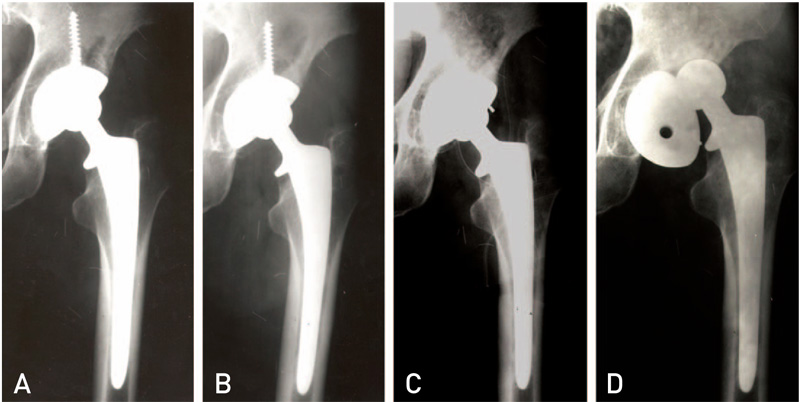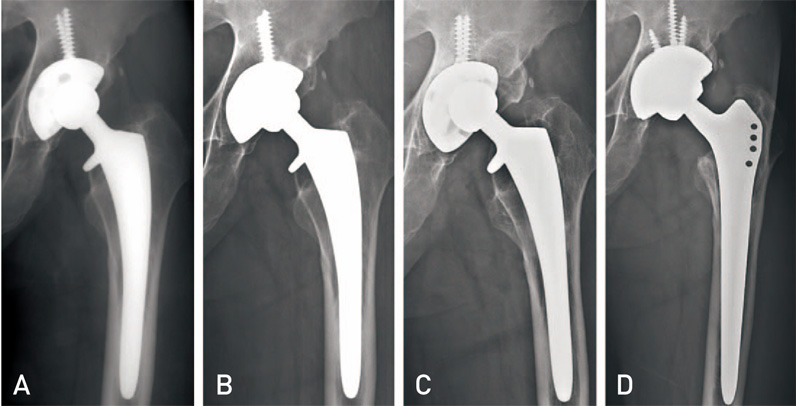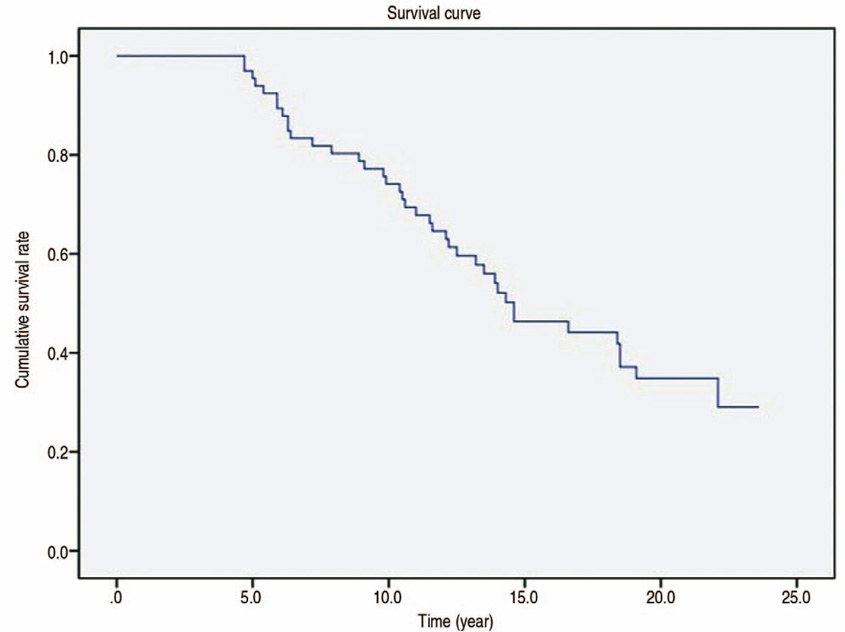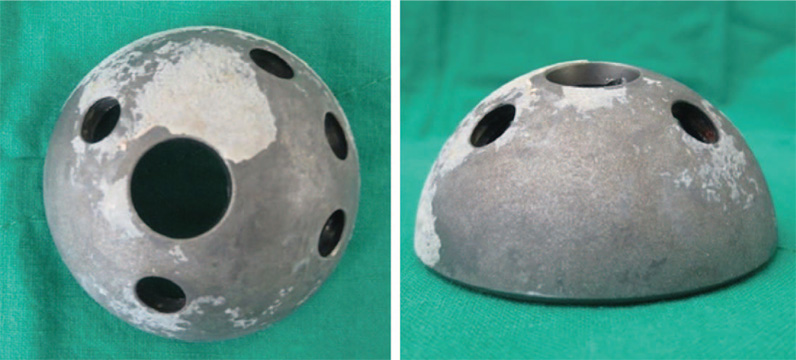Hip Pelvis.
2015 Dec;27(4):209-215. 10.5371/hp.2015.27.4.209.
The Results of Long-term Follow-up of Total Hip Arthroplasty Using Hydroxyapatite-coated Cups
- Affiliations
-
- 1Department of Orthopaedic Surgery, Yonsei University College of Medicine, Seoul, Korea. wsleeos@yuhs.ac
- KMID: 2150508
- DOI: http://doi.org/10.5371/hp.2015.27.4.209
Abstract
- PURPOSE
The aim of this study was to report the long-term outcome and the failure mechanism of cementless total hip arthroplasty (THA) using hydroxyapatite (HA)-coated acetabular cup.
MATERIALS AND METHODS
From January 1992 to May 1994, a total of 123 consecutive cementless primary THAs were performed using a HA-coated acetabular cup with metal-on-polyethylene articulation. We retrospectively evaluated 66 hips available for follow-up at a mean 18.3 years (range, 10.4-23.6 years). The survival analysis was performed by the Kaplan-Meier method. We defined end point as any failure that required a reoperation of acetabular component.
RESULTS
Thirty-nine of 66 hips (59.1%) were defined as a failure for progressive acetabular osteolysis or aseptic loosening of the cup. Acetabular osteolysis was observed in 47 hips (71.2%) and 33 hips (50.0%) were revised because of cup loosening. The Kaplan-Meier method showed the survival rate of the acetabular cup to be 46.3% at 15 years and 34.8% at 20 years for any failure that required a reoperation of acetabular component.
CONCLUSION
The long-term survival rate of THA using HA-coated acetabular cup was unsatisfactory, and it was attributed to vulnerable property of HA coating and progressive osteolysis.
MeSH Terms
Figure
Reference
-
1. Capello WN, D'Antonio JA, Manley MT, Feinberg JR. Hydroxyapatite in total hip arthroplasty. Clinical results and critical issues. Clin Orthop Relat Res. 1998; (355):200–211.2. Geesink RG, de Groot K, Klein CP. Chemical implant fixation using hydroxyl-apatite coatings. The development of a human total hip prosthesis for chemical fixation to bone using hydroxyl-apatite coatings on titanium substrates. Clin Orthop Relat Res. 1987; (225):147–170.3. Rossi P, Sibelli P, Fumero S, Crua E. Short-term results of hydroxyapatite-coated primary total hip arthroplasty. Clin Orthop Relat Res. 1995; (310):98–102.
Article4. Tonino AJ, Rahmy AI. The hydroxyapatite-ABG hip system: 5- to 7-year results from an international multicentre study. The International ABG Study Group. J Arthroplasty. 2000; 15:274–282.5. Castoldi F, Rossi R, La Russa M, Sibelli P, Rossi P, Ranawat AS. Ten-year survivorship of the Anatomique Benoist Girard I total hip arthroplasty. J Arthroplasty. 2007; 22:363–368.
Article6. Rogers A, Kulkarni R, Downes EM. The ABG hydroxyapatitecoated hip prosthesis: one hundred consecutive operations with average 6-year follow-up. J Arthroplasty. 2003; 18:619–625.7. Bidar R, Kouyoumdjian P, Munini E, Asencio G. Longterm results of the ABG-1 hydroxyapatite coated total hip arthroplasty: analysis of 111 cases with a minimum followup of 10 years. Orthop Traumatol Surg Res. 2009; 95:579–587.
Article8. Chung YY, Ki SC, So KY, Kim DH, Park KH, Lee YS. High revision rate of hydroxyapatite-coated ABG-I prosthesis. J Orthop Sci. 2009; 14:543–547.
Article9. Coathup MJ, Blackburn J, Goodship AE, Cunningham JL, Smith T, Blunn GW. Role of hydroxyapatite coating in resisting wear particle migration and osteolysis around acetabular components. Biomaterials. 2005; 26:4161–4169.
Article10. Kim SY, Kim DH, Kim YG, Oh CW, Ihn JC. Early failure of hemispheric hydroxyapatite-coated acetabular cups. Clin Orthop Relat Res. 2006; 446:233–238.
Article11. Lai KA, Shen WJ, Chen CH, Yang CY, Hu WP, Chang GL. Failure of hydroxyapatite-coated acetabular cups. Ten-year follow-up of 85 Landos Atoll arthroplasties. J Bone Joint Surg Br. 2002; 84:641–646.12. Lazarinis S, Kärrholm J, Hailer NP. Increased risk of revision of acetabular cups coated with hydroxyapatite. Acta Orthop. 2010; 81:53–59.
Article13. Paulsen A, Pedersen AB, Johnsen SP, Riis A, Lucht U, Overgaard S. Effect of hydroxyapatite coating on risk of revision after primary total hip arthroplasty in younger patients: findings from the Danish Hip Arthroplasty Registry. Acta Orthop. 2007; 78:622–628.
Article14. Stilling M, Rahbek O, Søballe K. Inferior survival of hydroxyapatite versus titanium-coated cups at 15 years. Clin Orthop Relat Res. 2009; 467:2872–2879.
Article15. Blacha J. High osteolysis and revision rate with the hydroxyapatite-coated ABG hip prostheses: 65 hips in 56 young patients followed for 5-9 years. Acta Orthop Scand. 2004; 75:276–282.
Article16. Delank KS, Drees P, Menzel N, Hansen T, Duschner H, Eckardt A. Increased polyethylene wear after cementless ABG I total hip arthroplasty. Arch Orthop Trauma Surg. 2006; 126:509–516.
Article17. Duffy P, Sher JL, Partington PF. Premature wear and osteolysis in an HA-coated, uncemented total hip arthroplasty. J Bone Joint Surg Br. 2004; 86:34–38.
Article18. Røkkum M, Reigstad A, Johansson CB. HA particles can be released from well-fixed HA-coated stems: histopathology of biopsies from 20 hips 2-8 years after implantation. Acta Orthop Scand. 2002; 73:298–306.19. Røkkum M, Reigstad A, Johansson CB, Albrektsson T. Tissue reactions adjacent to well-fixed hydroxyapatitecoated acetabular cups. Histopathology of ten specimens retrieved at reoperation after 0.3 to 5.8 years. J Bone Joint Surg Br. 2003; 85:440–447.20. Tonino A, Oosterbos C, Rahmy A, Thèrin M, Doyle C. Hydroxyapatite-coated acetabular components. Histological and histomorphometric analysis of six cups retrieved at autopsy between three and seven years after successful implantation. J Bone Joint Surg Am. 2001; 83-A:817–825.21. Tonino AJ, van der Wal BC, Heyligers IC, Grimm B. Bone remodeling and hydroxyapatite resorption in coated primary hip prostheses. Clin Orthop Relat Res. 2009; 467:478–484.
Article22. Harris WH. Traumatic arthritis of the hip after dislocation and acetabular fractures: treatment by mold arthroplasty. An end-result study using a new method of result evaluation. J Bone Joint Surg Am. 1969; 51:737–755.
Article23. DeLee JG, Charnley J. Radiological demarcation of cemented sockets in total hip replacement. Clin Orthop Relat Res. 1976; (121):20–32.
Article24. Dorr LD, Absatz M, Gruen TA, Saberi MT, Doerzbacher JF. Anatomic Porous Replacement hip arthroplasty: first 100 consecutive cases. Semin Arthroplasty. 1990; 1:77–86.25. Massin P, Schmidt L, Engh CA. Evaluation of cementless acetabular component migration. An experimental study. J Arthroplasty. 1989; 4:245–251.26. Livermore J, Ilstrup D, Morrey B. Effect of femoral head size on wear of the polyethylene acetabular component. J Bone Joint Surg Am. 1990; 72:518–528.
Article27. Brooker AF, Bowerman JW, Robinson RA, Riley LH Jr. Ectopic ossification following total hip replacement. Incidence and a method of classification. J Bone Joint Surg Am. 1973; 55:1629–1632.28. Cheung KW, Yung SH, Wong KC, Chiu KH. Early failure of smooth hydroxyapatite-coated press-fit acetabular cup--7 years of follow-up. J Arthroplasty. 2005; 20:627–631.
Article29. Reikerås O, Gunderson RB. Long-term results of HA coated threaded versus HA coated hemispheric press fit cups: 287 hips followed for 11 to 16 years. Arch Orthop Trauma Surg. 2006; 126:503–508.
Article30. Oosterbos CJ, Rahmy AI, Tonino AJ, Witpeerd W. High survival rate of hydroxyapatite-coated hip prostheses: 100 consecutive hips followed for 10 years. Acta Orthop Scand. 2004; 75:127–133.
Article31. Baker PN, McMurtry IA, Chuter G, Port A, Anderson J. THA with the ABG I prosthesis at 15 years. Excellent survival with minimal osteolysis. Clin Orthop Relat Res. 2010; 468:1855–1861.
Article32. Dumbleton JH, Manley MT. "The lysis threshold": an erroneous and perhaps misleading concept? By Harris WH. J Arthroplasty. 2003; 18:537–538.
- Full Text Links
- Actions
-
Cited
- CITED
-
- Close
- Share
- Similar articles
-
- Short-term Results after Cementless Total Hip Arthroplasty Using a Fully Hydroxyapatite-coated Femoral Stem
- Cementless Total Hip Arthroplasty Using Hydroxyapatite-Coated Femoral stem. - Two-Year Clinical and Radiologic Follow-UP-
- Bone Ingrowth into Harris-Galante Porous-coated Acetabular Cup Retrieved during Revision
- Cementless Acetabular Revision Performed with Morselized Bone Grafts:A Ten-Year Minimum Follow-Up
- Total Hip Arthroplasty with Hydroxyapatite-Coated Cementless Acetabular Cup : Minimum 10-Year Follow-up Result





